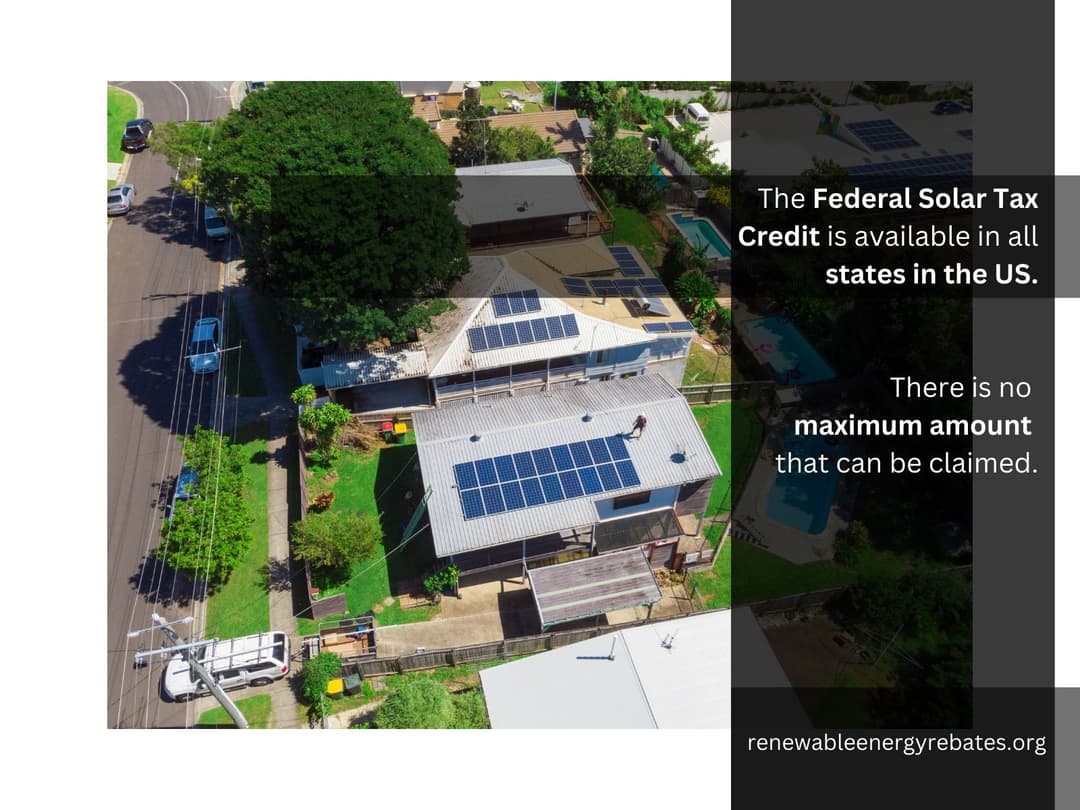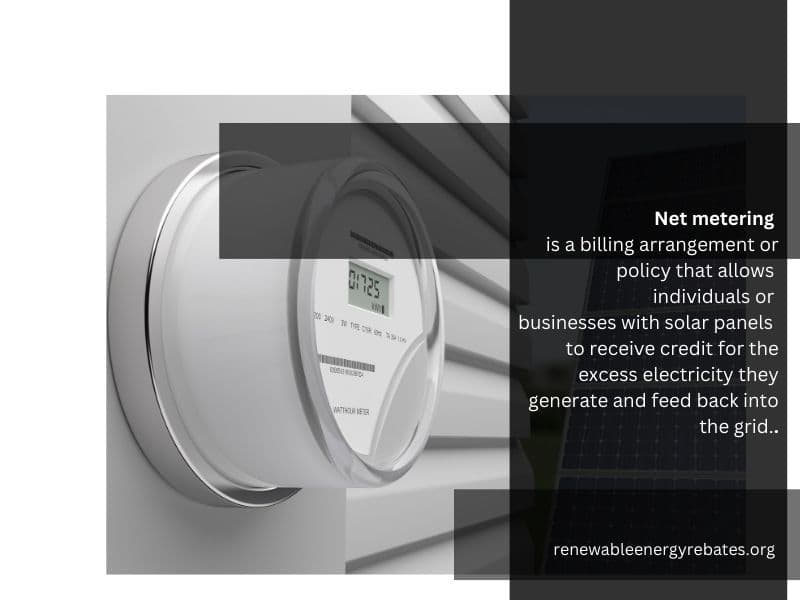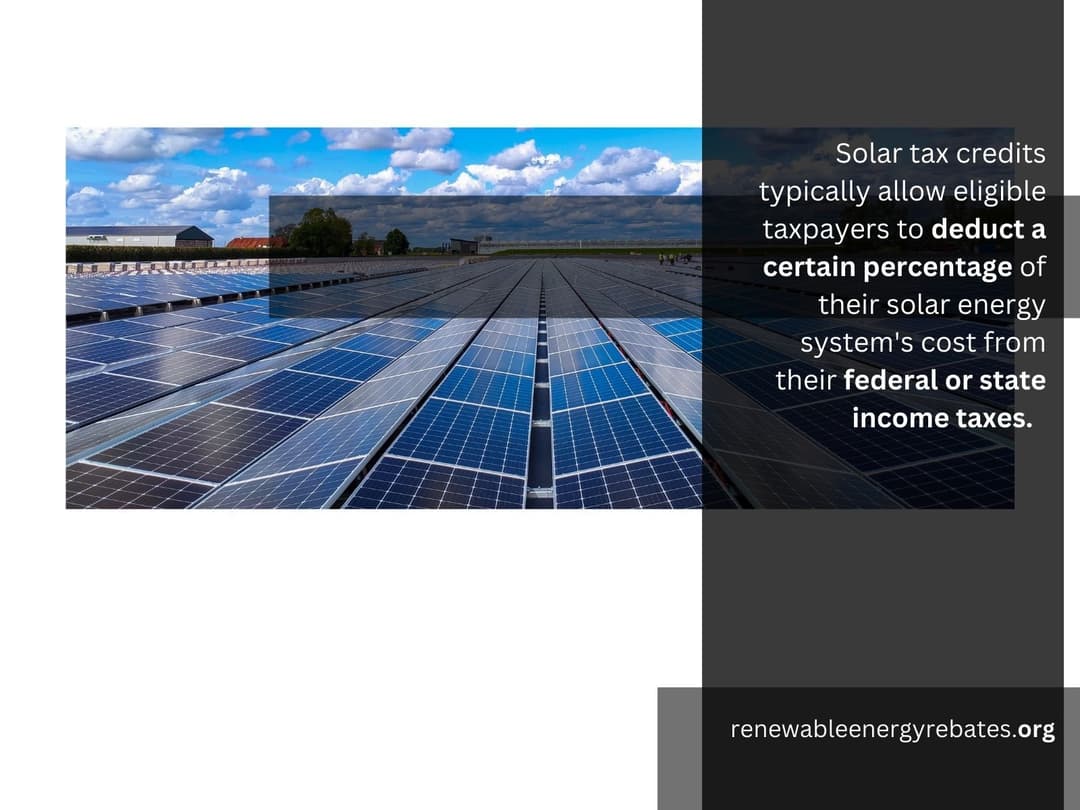Arizona Solar Rebates and Incentives
How Much Can You Save on Solar in Arizona?
Key Details
- Federal Solar Tax Credit in Arizona allows up to 30% deductions.
- Net Energy Metering in Arizona provides credits on utility bills for homes with solar PV systems connected to the grid.
- Residential Arizona Solar Tax Credit reduces income tax liabilities by up to $1,000
- Solar Sales Tax Exemption lets retailers in Arizona exempt buyers from the sales taxes on eligible solar energy devices.
- Arizona Property Tax Exemption excludes homeowners from paying taxes on increased property value brought about by eligible solar energy devices.
Arizona receives the most sunlight in the United States, with an estimated average of 5,755 kilojoules per square meter (kJ/m2). As of 2023, the Grand Canyon State had up to 243 solar installations, generating 6,087 megawatts.

The U.S. Energy Information Administration (EIA) estimates that total energy consumption per capita for 2020 was 210.1 million British thermal units (Btu) in Arizona.
In 2020, Arizona's energy consumption per capita for residents was 61.5 Million Btu.
In comparison, the transportation, commercial, and industrial sectors consumed 70.8 million Btu, 46.6 million Btu, and 31.3 million Btu of energy, respectively.
Arizona Solar Tax Credit and Incentives at a Glance
| Arizona Solar Incentives | State or Federal | Program Overview |
| Federal Solar Tax Credit or Residential Clean Energy Credit | Federal | Helps eligible persons get a percentage of the solar panel and installation cost deducted from federal income taxes. |
| Residential Arizona Solar Tax Credit | State | Allows residents to deduct up to $1,000 or 25% of solar installation cost from income taxes. |
| Arizona solar sales tax exemption | State | Excludes solar energy devices from sales tax or TPT, reducing tax for retailers and the cost of devices for buyers. |
| Arizona property tax exemption | State | Exempts homeowners from paying taxes on the increased property value brought about by solar energy devices. |
| Net metering or billing | State | Provides an opportunity to reduce utility bills and earn meter credits using their solar PV systems. |
How Cheap or Affordable is Solar Energy in Arizona?
According to the U.S. Energy Information Administration (EIA), Arizona’s average retail price of grid electricity in 2021 was 10.73 cents per kWh. If a household uses 1,200kWh monthly, the bill would be $128.76 monthly and $1,545.12 yearly.
In comparison, the average cost per watt of solar systems in Arizona is around $2.60 without incentives.
| State | Number of solar Installations | MW Installed | Average cost for grid power (2021) | Average cost per watts (solar) |
| Arizona | 243 | 6,087 | 10.73 cents/kWh | $2.60 |
Installing a 6kW solar system costs approximately $15,600. However, claiming the federal solar energy incentive can help offset the cost of solar panel installation in Arizona and shorten the payback period.
For instance, claiming a federal solar tax credit can offset the installation costs by 30%, reducing the price of a 6kW solar system installation to $10,920, a $4,680 savings.
| State | Cost of installing a 6kw system | Federal tax credit value 2023 (30%) |
| Arizona | $15,600 | $10,920 |
Federal Solar Tax Credit in Arizona
Created by the Energy Policy Act of 2005, the federal solar tax credit is an incentive funded by the federal government to encourage investment into renewable energy resources.

Also called the Investment Tax Credit (ITC) or the Residential Clean Energy (RCE) Credit, the solar tax credit allows persons in Arizona with residential solar systems to deduct a percentage of the solar system cost from owed federal income taxes.
The solar energy incentive does not immediately reduce the price of solar panels or installation. Instead, it compensates homeowners in Arizona by reducing their total income tax liability by 30% of the total cost (equipment, labor, and permits) or less, depending on the year the solar system was installed.
If the owed tax is lesser than the credit, the credit can roll over to subsequent tax years.
According to the Act, the rate schedule by year for solar PV systems are as follows:
- Before 2020: 30%
- From 2020 to 2021: 26%
- From 2022 to 2032: 30%
- 2033: 26%
- 2034: 22%
Moreover, the solar tax credit also applies to qualified battery storage technologies, as long as they meet connection and minimum capacity requirements. However, unless renewed, this solar incentive for battery storage will only apply to battery storage installed from 2022 to 2032.
Non-profits, municipalities, and tax-exempt entities can also receive a refund on tax credit from the IRS on solar projects operating after 2022.
Note: The Residential Clean Energy Credit is a renewable energy tax credit that is not limited to solar but also includes wind turbines, geothermal heat pumps, and other applicable renewable resources.
Eligibility
To qualify for the federal tax credit in Arizona, you must be a homeowner and own a solar PV system. Requirements for the federal solar tax credit also include:
- The solar system and qualifying components must be new or be in use for the first time
- Homeowners must pay for the solar system with cash, loans, or financing programs
- The PV system should be installed at the homeowner’s primary or secondary residence in the country
- The system installation must be finished during the tax year
The Residential Clean Energy Credit only applies to federal tax liabilities and not state or local taxes. Additionally, this incentive only covers the following solar equipment:
- Solar panels or PV cells
- Battery or energy storage technology with at least 5kWh storage capacity
- Inverters, wiring, mounting equipment, and other eligible balance-of-system equipment
- Qualifying solar roofing shingles and solar roofing tiles (structural or roofing components like rafters or roof decking do not qualify)
- Installation and contractor fees, including labor cost, inspection cost, permit fees, and developer fees
- Concentrating solar-thermal power (CSP) equipment like water heaters for indoor use. Solar-powered heating for hot tubs and swimming pools does not qualify.
- Sales taxes on the qualified expenses listed above.
How do I claim the Federal Solar Tax Credit in Arizona?
To claim the federal tax credit in Arizona, eligible homeowners should fill out and include the IRS Residential Energy Credit form in the usual federal tax process. Applicants may follow these steps for specific federal solar tax credit instructions:
Step 1. Read the instructions for form 5695. Use the Credit Limit Worksheet included and the Income Tax Return Form (form 1040) to figure out the amount to include in form 5695. Note that if the credit amount exceeds the liability limit, you can use the remaining credit in the next tax year.
Step 2. Fill IRS Residential Energy Credit form (form 5695). Enter the amount paid for qualified solar installments and solar water heating equipment (lines 1 and 2). Then multiply by 30% (0.30) to answer lines 6b and 13
Step 3. Then include the amounts from the worksheet to answer lines 14 and 15.
Step 4. If there is a carryforward of the credit amount as specified in step 1, fill in line 16 of form 5695.
Step 5. Answer and fill lines 17a, 17b, and 17c.
Step 6. Use the Lifetime Limitation Worksheet in the instruction to answer line 18 and the Energy Efficient Home Improvement Credit Limit Worksheet to answer lines 29 and 30 (if applicable)
Step 7. Include the credit amounts in Schedule 3, line 5 of Form 1040 (if applicable).
Step 8. Review forms
Step 9. Attach complete Form 5695 to Form 1040
Step 10. Send forms to the usual IRS address for Arizona.
Net Energy Metering in Arizona
Net metering is an arrangement or billing mechanism that offers persons with renewable energy sources (like solar PV systems) credits on their utility bill when they send unused energy generated by the system to the grid.
Under this program, residents in Arizona with solar system installations can remain connected to their utility provider, feed excess energy into the grid, and use the credits to purchase electricity back when the PV system is not generating any or enough energy.
Net metering offers a one-to-one retail rate. This means that there is an equal exchange, i.e., what you pay for energy is what will be credited to your meter when you export energy.
Arizona Net Billing
In December 2016, the Arizona Corporation Commission discontinued net metering in Arizona. Instead, the state offers net billing, a similar program with a lower credit rate and, consequently, lesser potential savings on one’s electric bill.
According to Arizona Administrative Code § 14-2-2306, utility companies in the state get to set their credit rates annually by using the Resource Comparison Proxy (RCP) rate.
Although net billing may make it longer to recover the solar installation costs through electric bill savings, homeowners in Arizona can access several renewable energy incentives to shorten the payback period.

How to Enroll for Net Energy Billing in Arizona
Interested persons have to be connected to the grid to enroll for net energy metering in Arizona. If you already have a solar PV system installed, your installer probably connected the system to the grid unless you chose to depend only on the solar PV system and battery storage for electricity.
However, if you have not installed a solar system or are yet to connect to the grid, you can do this with the help of a licensed contractor and your utility provider.
According to Arizona Revised Statutes (ARS) § 44-1764 (2020), persons who want to connect their solar energy system to a utility provider’s power grid must apply for interconnection.
To connect your PV system to the grid and enroll for net energy billing in Arizona, the following steps may be necessary depending on your utility provider:
Step 1. Check the utility provider’s website for interconnection requirements and agreements. Requirements may cover technical system standards, lists of accepted components, installer/contractor qualifications, and the type of existing customers that are eligible for enrollment. Application forms for interconnection may also be available online.
Step 2. Contact or hire your installer to fulfill requirements and submit an application. The utility provider may request additional documents like site plans and agreements.
Step 3. Receive confirmation letter upon application review and approval. The installer should then follow the utility provider’s guide and get the necessary permits and components for installation.
Step 4. Install the system and provide the utility company with the Certificate of Completion
Step 5. The utility provider inspects the system installation and performs tests to verify system performance
Step 6. Further correction and inspection (if needed)
Step 7. Install the net billing meter. This may be done by the installer or utility provider. Be sure to confirm the pricing plan and billing rate for your installation period because the same rate will apply for up to ten years.
Note: Residents can use the statement of solar installation costs or certificates from contractors to claim an Arizona renewable energy rebate or incentive.
Residential Arizona Solar Tax Credit in Arizona
The residential Arizona solar tax credit is a renewable energy incentive created by Arizona Revised Statutes § 43-1083 under the Arizona Renewable Energy Tax Incentive Program.
Similar to the federal solar tax credit, the Arizona solar panel tax credit helps residents in Arizona offset solar installation costs by reducing income tax liability by up to $1,000 or 25% of the cost of solar devices, whichever is lesser.
However, the Arizona tax credit for solar panels only applies to the state income tax. Residents can claim this credit during their tax process and even carry over excess credit for up to 5 years.
Eligibility
Before claiming the Residential Arizona Solar Tax Credit, interested persons - and the solar system - have to meet the following qualifications:
- Applicants reside in Arizona, and the solar PV system must be located in the state.
- Applicants must not be dependent on another taxpayer.
- Applicants must have purchased the solar energy device. Solar devices owned under a lease or power purchase agreement (PPA) do not qualify.
- The solar PV system should be installed on a property owned or leased by the taxpayer
- The solar PV system and solar installer must meet the standards specified under ARS § 44-1762 (2020).
The Arizona Department of Revenue (ADOR) is responsible for accepting and approving applications for solar tax credits. However, only the following devices qualify for Arizona residential solar tax credit:
- Solar PV systems, including inverters, batteries, collectors, and wiring used specifically for PV systems applications
- Passive solar building systems and components especially designed for energy production.
- Solar domestic water heating systems such as heat exchangers, storage tanks, valves, collectors, and wiring directly related to the solar system. Conventional heating/cooling systems and plumbing components do not qualify.
- Solar PV street lighting and phones manufactured specifically for photovoltaic applications
- Solar swimming spa and pool heating systems, such as heat exchangers, piping, valves, collectors, and wiring directly related to the solar system.
- Solar daylighting systems and equipment clearly designed to capture and redirect visible solar energy while controlling the infrared energy
To ensure that your solar PV system is eligible, it is ideal to collect a certificate stating that the solar energy device complies with Arizona's solar energy device requirements.

How do I claim the Residential Arizona Solar Tax Credit in Arizona?
To claim the Residential Arizona Solar Tax Credit, interested persons need to send an application to the Arizona Department of Revenue (ADOR). Generally, eligible individuals have to include Form 310 with their regular income tax documents. The following steps may help:
- Download and read the instructions for form 310. The instructions include eligibility requirements and a line-by-line guide to filling out the solar tax credit application form.
- Download and fill out form 310 using the instructions. Ensure to confirm inputted amounts and calculations using the statement of solar installation costs or certificates from contractors. Carryover credit can also be claimed using this form.
- Include information in form 301. This form is required as a summary of all the individual tax credit applications for that tax year.
- Include completed forms with tax returns, file, and make payment (if any)
Solar Sales Tax Exemption in Arizona
The solar sales tax exemption in Arizona is an incentive that exempts registered solar retailers in the state from paying transaction privilege tax (TPT) on solar energy devices as per ARS § 42-5159 (subsection E).
In 2006, the $5,000 cap on the tax exemptions was removed. Therefore, eligible retailers can get 100% coverage on the sales tax exemption, and consequently, solar devices sold by these retailers are free from the sales tax imposed on the buyer.

According to ARS § 42-5061, solar retailers and prime contractors that supply and install solar devices can register with the Arizona Department of Revenue to claim this incentive.
Retailers can register by sending filled application forms to ADOR.
Note: By registering, the retailer will have to provide sales records to the ADOR for examination.
Arizona Property Tax Exemption
Solar PV system installations usually increase property value, and while this should lead to a subsequent increase in property taxes, the Arizona property tax exemption saves homeowners in the state from this potential tax increase.
Created in 2006 and expanded in 2009, the Arizona property tax exemption, the Arizona property tax exemption excludes homeowners from paying taxes on the increased property value brought about by the eligible solar devices.
As per ARS § 42-11054, the following devices are not considered to add value to housing during property tax assessment:
- Grid-tied PV systems and over devices specifically designed for solar energy generation and on-site consumption
- Combined heat and power system
- Solar energy devices as per ARS § 44-1761
- Renewable energy equipment
- Energy efficient building components.
The exemption will be applied during property assessment.
Arizona Household Profile
According to the 2021 Census estimates, there are 3,138,685 housing units in Arizona. Out of the total housing units, 320,962 units (10.2%) are vacant, and 2,817,723 units (89.8%) are occupied.
Data for the same year show that 32.4% of occupied housing units are renter-occupied, while the owner-occupied housing unit rate is 67.6%. In addition, the median value of owner-occupied housing units was $336,300.
Lastly, data from Arizona Commerce Authority indicates that there were 5,738 authorized building permits issued in Arizona in 2022.
Renewable in Arizona
In 2021, around 16% of Arizona's total net energy generation came from renewable energy facilities of different sizes. These renewable energy resources mainly include solar, wind, and hydroelectric power generation.
Utility and small-scale solar PV facilities and the one solar thermal power plant in Arizona accounted for 9% of net electricity generation in the state. This made the Grand Canyon state the fifth-highest state for net solar energy generation, following California, Texas, Florida, and North Carolina.
Meanwhile, hydroelectric plants in Arizona produced around 5% of in-state net energy generation, while wind farms supplied less than 2%. However, the largest percentage (43%) of energy generated in Arizona was fueled by natural gas, followed by nuclear power and coal, with 28% and 13%, respectively.
Compared to other states, Arizona has the sixth-lowest per capita energy consumption rate. Arizona residents do not have the opportunity to buy 100% clean energy from their utility providers.
In 2022, the Arizona Corporation Commission rejected a 100% clean energy package that would have boosted energy efficiency and increased the adoption of zero carbon emission resources.